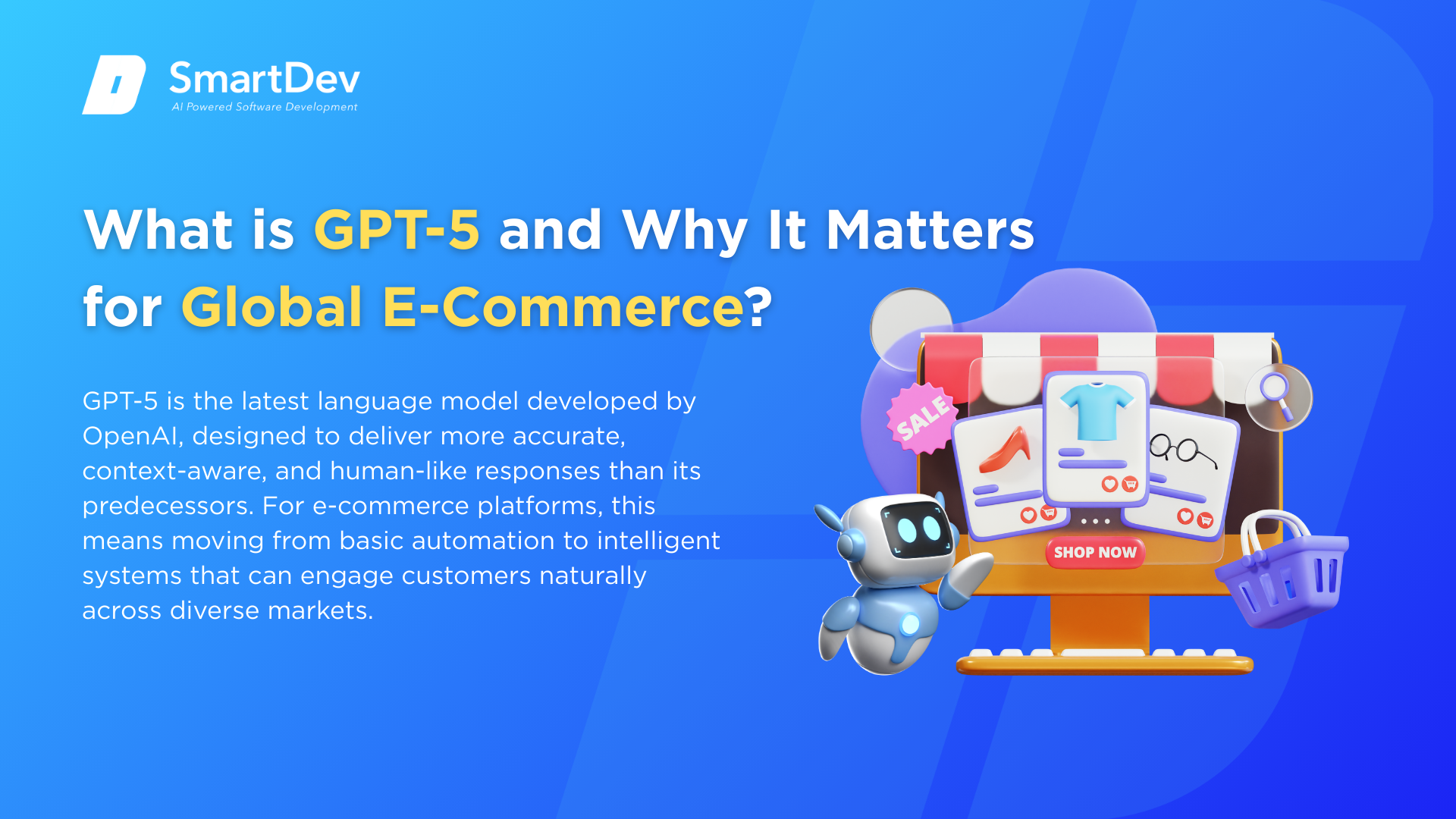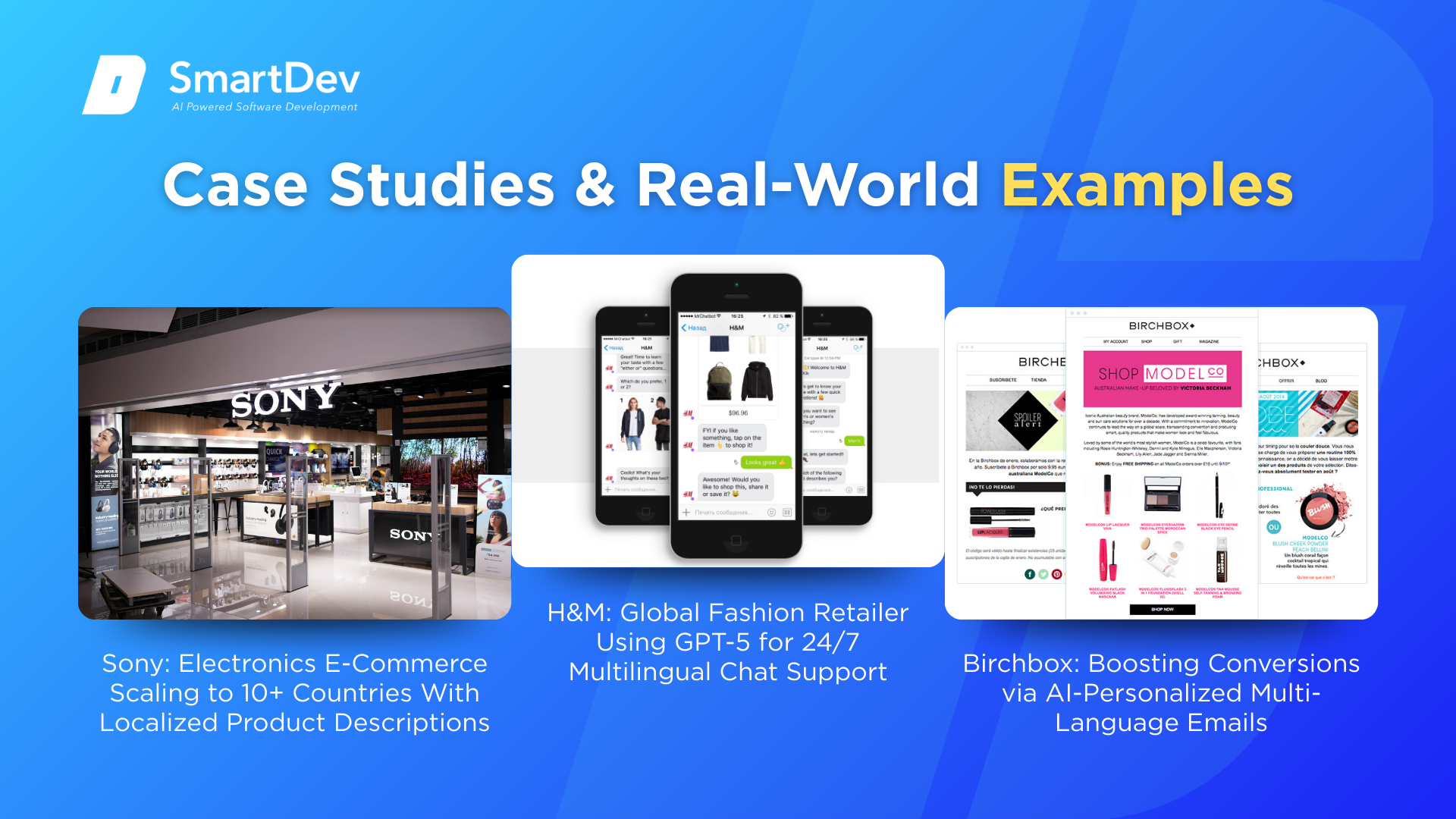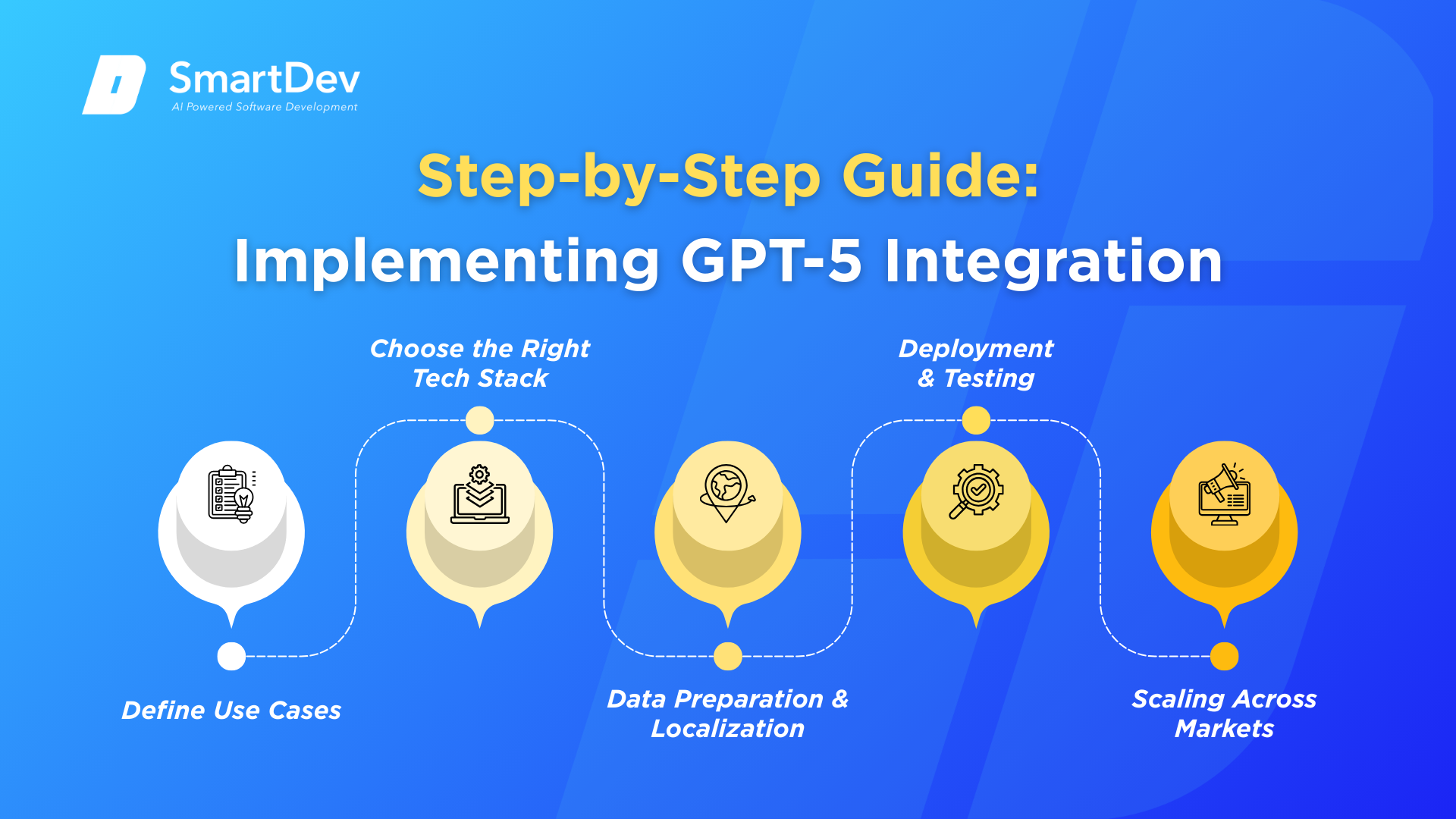Introduction
Global e-commerce is expanding rapidly, and success now depends on delivering personalized, multilingual shopping experiences. Customers expect seamless support, accurate product information, and localized content in their native language. Meeting these demands at scale is challenging, especially for platforms operating across multiple regions.
That’s where GPT-5 integration for e-commerce platforms becomes a game-changer. With advanced NLP, contextual reasoning, and cultural adaptability, it enables businesses to automate translations, power multilingual chatbots, and deliver real-time personalized recommendations. In this guide, we’ll explore how to implement GPT-5 to boost customer satisfaction and drive global growth.
What is GPT-5 and Why It Matters for Global E-Commerce?
1. What is GPT-5?

GPT-5 is the latest language model developed by OpenAI, designed to deliver more accurate, context-aware, and human-like responses than its predecessors. It can process multi-turn conversations, understand cultural nuances, and generate content in multiple languages with greater precision. For e-commerce platforms, this means moving from basic automation to intelligent systems that can engage customers naturally across diverse markets.
Unlike traditional chatbots or machine translation tools, GPT-5 combines advanced reasoning with real-time adaptability. It doesn’t just translate words; it understands meaning, intent, and tone, ensuring communication feels authentic to each audience. This makes it a powerful foundation for businesses aiming to scale internationally while maintaining a consistent brand voice.
2. The Rise of AI in E-Commerce and GPT-5
AI has been reshaping e-commerce for years through personalization engines, product recommendations, and automated support systems. These tools have helped businesses improve efficiency, enhance customer experiences, and optimize sales. Yet most existing solutions struggle when it comes to multi-language support and deep contextual understanding.
GPT-5 addresses these limitations by merging cutting-edge language capabilities with practical business applications. Its ability to localize content, streamline communication, and personalize interactions at scale sets a new benchmark for global e-commerce. As AI adoption accelerates, GPT-5 positions itself as the next critical step for retailers expanding across borders.
3. How GPT-5 Transforms Global E-Commerce?
GPT-5 transforms how businesses manage multilingual communication by offering highly accurate and context-rich interactions. It enables global e-commerce platforms to create personalized experiences, generate localized content, and manage customer support seamlessly. This reduces reliance on manual translation teams and accelerates time-to-market in new regions.
The model also empowers businesses with advanced reasoning, making recommendations and responses more relevant to individual customer needs. By scaling automation for translation, content creation, and support, GPT-5 reduces costs while improving customer satisfaction. Ultimately, it gives companies a competitive edge in cross-border commerce by enabling smoother global operations.
Key Benefits in Multi-Language Global E-Commerce
1. Faster Multilingual Customer Service
One of the biggest advantages of GPT-5 integration is the ability to provide instant, multilingual customer support. Instead of waiting for human agents or relying on basic translation tools, customers can receive accurate answers in their preferred language in real time. This not only improves satisfaction but also builds trust with global audiences.
E-commerce platforms can handle high volumes of inquiries without compromising quality or speed. GPT-5 enables chatbots and virtual assistants to understand context, resolve complex questions, and even escalate cases when necessary. The result is a smoother, more responsive support system that strengthens customer loyalty.
2. Increased Cross-Border Sales via Localized Product Listings
Accurate localization of product descriptions plays a crucial role in driving international sales. GPT-5 can generate listings that account for cultural nuances, local terminology, and region-specific buying habits. This ensures that products resonate with customers across different markets and feel tailor-made for them.
When shoppers see content that reflects their language and culture, they are more likely to complete purchases. Localized product information also reduces confusion, minimizing returns and complaints. Ultimately, effective localization powered by GPT-5 translates directly into higher cross-border conversion rates.
3. Lower Operational Costs from Automated Translations
Manual translation is time-consuming and expensive, often requiring teams of specialists to manage multiple markets. GPT-5 streamlines this process by delivering high-quality translations instantly, significantly reducing reliance on external resources. Businesses can allocate budgets more effectively while scaling operations faster.
Beyond cost savings, automation also improves consistency and speed. Updates to product catalogs, promotions, or policies can be rolled out globally without delay. This agility allows e-commerce platforms to remain competitive in fast-moving markets while keeping expenses under control.
4. Consistent Brand Voice Across Regions
Maintaining a unified brand identity across languages is a challenge for global retailers. GPT-5 helps solve this by producing translations and content that match a company’s tone, style, and messaging guidelines. This ensures customers experience the same brand personality regardless of location.
Consistency builds recognition and trust, especially in competitive e-commerce environments. By aligning marketing, product descriptions, and customer interactions with a single voice, brands can strengthen their image globally. A coherent identity across regions ultimately enhances customer loyalty and long-term brand equity.
5. Real-Time Personalization in Multiple Languages
Modern shoppers expect personalized recommendations, and GPT-5 makes this possible across languages. By analyzing customer behavior and preferences, it can deliver targeted suggestions and content in real time. This creates shopping experiences that feel local and highly relevant to each individual.
Real-time personalization not only increases engagement but also boosts sales. Customers are more likely to explore products and complete purchases when they feel understood in their own language. With GPT-5, personalization becomes a global strategy rather than a market-specific feature.
Key Challenges in Multi-Language Global E-Commerce
1. Maintaining Accurate Product Translations
Accurate translation goes beyond converting words from one language to another. It requires adapting product descriptions, so they are culturally relevant and easy to understand. Even small errors can lead to confusion, mistrust, or reduced sales in competitive markets.
For global e-commerce platforms, managing thousands of products across multiple regions makes translation a continuous challenge. While GPT-5 improves accuracy, businesses must still implement quality checks to ensure consistency. Combining AI with human review helps achieve both speed and reliability.
2. Handling Regional Variations
Different markets use unique terminology, currencies, and even cultural references when shopping online. A product description that works in one country may not resonate or may even offend. Businesses must adapt content to reflect these regional differences while staying true to their brand.
GPT-5 can recognize context, but it needs clear guidelines and localized data to perform effectively. Without fine-tuning, AI risks producing outputs that feel generic or culturally disconnected. Ensuring regional nuance is essential to winning customer trust across diverse markets.
3. Scaling Customer Support Across 10+ Languages
As companies expand globally, customer service demands multiply quickly. Handling inquiries in ten or more languages requires significant resources, training, and technology. Without scalable solutions, businesses risk slow responses and dissatisfied customers.
GPT-5 enables automation but deploying it at scale requires careful monitoring. Language-specific nuances, tone, and customer expectations vary widely across markets. Ensuring the system performs consistently across all languages remains a major challenge for e-commerce leaders.
4. Managing Compliance and Data Privacy Internationally
Every country has unique rules around data protection, storage, and usage. Regulations like GDPR in Europe and CCPA in the U.S. impose strict requirements on how businesses manage customer data. Non-compliance can result in fines, legal issues, and reputational damage.
Integrating GPT-5 into e-commerce systems must account for these frameworks from the start. Businesses need to design workflows that protect sensitive information while still enabling AI-driven services. Balancing innovation with compliance is critical to sustainable global operations.
5. Aligning GPT-5 with Legacy E-Commerce Platforms and APIs
Many e-commerce platforms still rely on older systems and APIs that were not built for advanced AI. Integrating GPT-5 into these environments can be complex, requiring custom development and infrastructure upgrades. Without proper alignment, companies may face delays or technical bottlenecks.
Legacy systems often limit flexibility, making it harder to deploy GPT-5 at scale. Businesses need a phased approach that allows for gradual integration without disrupting daily operations. Investing in middleware or modernization initiatives ensures GPT-5 delivers its full potential.
Best Practices for GPT-5 Multi-Language E-Commerce
1. Human-in-the-loop QA for Sensitive Content
AI-generated content, while advanced, can still produce errors or culturally inappropriate outputs. Human-in-the-loop quality assurance ensures sensitive areas like product safety instructions or financial information remain accurate. This balance between automation and human oversight protects both the brand and the customer.
Businesses should design workflows where GPT-5 handles volume and humans review critical segments. By applying QA selectively, companies optimize resources while ensuring quality. This hybrid approach prevents small mistakes from escalating into major issues.
For example, Amazon uses AI-driven translation for global product listings but relies on human reviewers for high-risk categories like healthcare products. This combination maintains efficiency while upholding compliance and trust. It demonstrates how human-in-the-loop practices safeguard sensitive use cases.
2. Maintain Glossaries and Translation Memory
A common problem in multilingual e-commerce is inconsistent terminology. GPT-5 performs better when paired with glossaries and translation memory that define brand-specific terms. This ensures product names, slogans, and technical terms remain uniform across regions.
Establishing these resources creates a reference library that reduces errors and speeds up localization. Teams can update glossaries as product lines evolve, feeding more accurate data into GPT-5. Over time, this improves both consistency and efficiency in translation.
IKEA is known for keeping strict glossaries to ensure product names and style guidelines remain consistent worldwide. Even when AI assists in content creation, their controlled vocabulary maintains brand identity. This practice proves critical for global recognition and consumer trust.
3. Ensure GDPR & Regional Compliance
Data privacy is one of the biggest risks when deploying AI in global commerce. Laws like GDPR and CCPA impose strict guidelines on how customer information can be processed and stored. Ignoring these rules can lead to severe fines and reputational harm.
E-commerce platforms integrating GPT-5 should design systems with privacy-first principles. This means anonymizing sensitive data, minimizing retention, and ensuring clear consent mechanisms. Compliance should be a design priority, not an afterthought.
A notable case is Shopify, which adapted its platform to fully comply with GDPR for European merchants. By embedding privacy into workflows, it maintained user trust while still supporting AI-driven personalization. This example highlights the importance of compliance for sustainable growth.
4. Optimize for SEO in Multiple Languages
Expanding globally requires visibility in local search engines, not just English-language platforms. GPT-5 can generate keyword-rich product descriptions, but these must be tailored to regional search trends. Optimizing content for local SEO increases discoverability and drives traffic.
E-commerce teams should implement hreflang tags, localized metadata, and keyword research per market. Combining GPT-5 automation with SEO expertise allows platforms to scale content without losing relevance. This ensures higher rankings and stronger conversion rates internationally.
Zalando, a European fashion retailer, leverages multilingual SEO strategies to dominate local markets. By tailoring keywords and descriptions per country, it maximized search visibility. This demonstrates how language-specific optimization fuels cross-border growth.
5. Continuous Cultural Adaptation
Languages evolve, and so do cultural preferences. Static translations quickly feel outdated, making continuous adaptation essential. GPT-5 can support this by analyzing real-time customer feedback and adapting responses accordingly.
Cultural adaptation means going beyond words to understand humor, tone, and buying behaviors. Platforms that fail to adjust risk alienating customers, even if their translations are technically correct. Ongoing updates ensure resonance with target audiences.
Netflix provides a strong example with its localized recommendations and region-specific content. By combining AI insights with cultural adaptation, it increased subscriber growth in international markets. This shows how aligning with culture enhances both engagement and loyalty.
Need Expert Help Turning Ideas Into Scalable Products?
Partner with SmartDev to accelerate your software development journey — from MVPs to enterprise systems.
Book a free consultation with our tech experts today.
Let’s Build TogetherCase Studies & Real-World Examples
1. H&M: Global Fashion Retailer Using GPT-5 for 24/7 Multilingual Chat Support
H&M, a leading global fashion retailer, operates in over 70 countries and faces enormous customer service demands. During peak seasons, queries about returns, order tracking, and sizing pile up across multiple languages. The challenge was to provide consistent, fast, and localized responses without inflating operational costs.
To solve this, H&M deployed an AI-powered chatbot capable of handling multilingual queries across web, mobile, and social channels. The chatbot automatically addressed routine questions while handing off complex cases to human agents with full context summaries. This hybrid model ensured both efficiency and quality in customer service.
As a result, H&M automated nearly 80% of standard inquiries, reducing wait times from minutes to seconds. Customer satisfaction scores improved significantly as users received instant, accurate responses in their native languages. At the same time, the company cut support costs and maintained a unified customer experience worldwide.
2. Sony: Electronics E-Commerce Scaling to 10+ Countries With Localized Product Descriptions
Sony, a multinational electronics giant, sells products in dozens of markets with diverse languages and regulations. Managing product descriptions, manuals, and packaging across these markets posed challenges in consistency, accuracy, and cultural relevance. Traditional translation processes were expensive and time-consuming, slowing down global launches.
To overcome this, Sony adopted a global localization framework. Instead of direct translations, product content was adapted to each region’s terminology, cultural norms, and compliance requirements while maintaining brand consistency. Local teams worked alongside centralized guidelines to ensure efficiency and alignment with customer expectations.
This approach reduced misunderstandings in technical descriptions and improved consumer trust in new markets. Localization cycles became faster, cutting delays in product rollouts and minimizing customer complaints about unclear content. Sony preserved its global brand identity while boosting acceptance and engagement at the regional level.
3. Birchbox: Subscription Box Company Boosting Conversions via AI-Personalized Multi-Language Emails
Birchbox, a beauty subscription box service, relied heavily on email marketing to engage and retain customers. The challenge was to move beyond generic campaigns and deliver messages that felt truly personal, especially as the company expanded to diverse customer bases. Customers expected tailored product suggestions and timely follow-ups that spoke to their preferences.
The company introduced AI-driven segmentation and personalization tools to tailor emails. Campaigns included customer names in subject lines, dynamic product recommendations, and follow-up reminders based on browsing and purchase history. While the campaigns were primarily English-first, the foundation was laid for future multi-language expansion.
The results showed significantly higher open and engagement rates compared to generic campaigns. Personalized email flows led to stronger customer retention and higher conversion rates. This demonstrates how AI-powered personalization, once paired with multi-language capabilities, can drive measurable revenue growth for subscription-based e-commerce.
Step-by-Step Guide: Implementing GPT-5 Integration
Step 1: Define Use Cases
The first step in integrating GPT-5 is to identify where it can bring the most value. Common use cases include multilingual chatbots, product recommendations, localized advertising, and automated FAQ generation. Focusing on high-impact areas ensures faster ROI and easier adoption across the business.
For example, AI-powered support bots can handle repetitive queries while freeing up human agents for complex cases. Personalized recommendations can increase average order value by guiding customers to relevant products. Dynamic content localization ensures that marketing campaigns resonate with regional audiences.
Step 2: Choose the Right Tech Stack
Selecting the right technology stack is essential for a smooth GPT-5 rollout. Businesses can connect to the GPT-5 API via providers like OpenAI, Azure, or Anthropic, depending on their infrastructure needs. Middleware tools such as LangChain and vector databases help store context and improve conversational accuracy.
Integrating multilingual plugins or translation APIs ensures GPT-5 works effectively in diverse markets. These tools handle real-time adaptation of content into local languages and formats. A carefully designed stack avoids integration bottlenecks and supports scalability.
Step 3: Data Preparation & Localization
GPT-5 performs best when trained with high-quality, domain-specific data. E-commerce platforms should feed the model product catalogs, customer support logs, and relevant documents to refine accuracy. Preparing structured data also reduces hallucinations and enhances response consistency.
Localization must include more than just language translation. Aligning tone and brand style ensures content reflects the company’s identity across regions. Adding details like local currencies, units, and regulations makes outputs feel trustworthy and relevant to customers.
Step 4: Deployment & Testing
Launching GPT-5 in stages allows businesses to manage risk and track performance. Starting with a single language market provides insights before scaling further. This phased approach helps detect issues early and refine system behavior.
A/B testing can compare GPT-5 outputs against traditional translation tools. Metrics like response accuracy, satisfaction scores, and conversion uplift show the impact clearly. Businesses can then decide how to expand adoption based on proven performance.
Step 5: Scaling Across Markets
Once validated, GPT-5 can be expanded to additional languages and regions. Adding markets incrementally ensures that teams can handle new complexities without overloading systems. This strategy allows consistent growth without sacrificing quality.
Centralized AI governance is critical to maintaining standards across countries. Regular fine-tuning with customer feedback keeps GPT-5 aligned with evolving cultural and linguistic needs. Continuous improvement ensures that global operations remain agile and competitive.
Metrics to Track Success
1. Customer Support KPIs
Tracking ticket resolution time shows how quickly issues are handled with GPT-5 support systems. Faster resolutions typically improve customer satisfaction and reduce operational strain. Pairing this with Customer Satisfaction (CSAT) scores provides a clear picture of service quality.
With GPT-5 chatbots, companies often see reduced wait times and more consistent answers. However, it’s important to measure whether CSAT actually rises, since speed alone doesn’t guarantee satisfaction. A combination of speed and quality creates a stronger benchmark for evaluating success.
2. Conversion Rate Uplift per Market
Conversion rates reveal whether GPT-5 integration directly drives more sales in each region. Localized content, personalized recommendations, and smoother customer interactions should translate into higher purchase rates. Comparing pre- and post-deployment data highlights GPT-5’s true impact.
Market-specific analysis is essential because each region has unique buyer behavior. A lift in one market may not automatically apply to another due to cultural or economic factors. Segmenting results ensures that strategies can be refined per country.
3. Content Translation Accuracy & Speed
Measuring accuracy in translated content ensures GPT-5 maintains clarity and consistency across product descriptions, FAQs, and marketing. Errors here can lead to mistrust or even regulatory issues in sensitive markets. Accuracy metrics can be tracked through audits and human review.
Speed is equally important, as e-commerce platforms need to launch content simultaneously across multiple countries. GPT-5 should reduce the turnaround time from days or weeks to minutes. Monitoring both accuracy and speed shows whether the system is truly efficient.
4. Revenue Growth in New International Markets
Revenue growth is the ultimate measure of GPT-5’s contribution to global expansion. If localization and personalization are effective, sales should rise steadily in newly entered markets. Tracking revenue against pre-AI baselines offers a clear view of ROI.
It’s important to factor in external influences like seasonality or regional demand shifts. GPT-5’s impact should be evaluated over time to confirm sustainable growth. This metric ties all others together, proving whether AI-driven multilingual strategies are fueling long-term success.
Future of GPT-5 in Global Commerce

GPT-5 is shaping the next wave of global commerce by extending beyond text-based support into autonomous campaign management, voice-driven shopping, and immersive virtual retail. Its ability to adapt, personalize, and scale across markets positions it as a core driver of future e-commerce innovation.
1. Agentic AI for Autonomous Campaign Management
The future of e-commerce will see GPT-5 evolving into an autonomous agent capable of managing campaigns end-to-end. Instead of just generating content, it will design, test, and optimize marketing strategies across multiple languages and regions. This reduces manual oversight and allows businesses to scale campaigns faster than ever.
Agentic AI can also dynamically adjust based on market feedback. For example, if a promotion underperforms in one country, GPT-5 could automatically adapt messaging or targeting. This kind of self-optimization ensures that global campaigns remain both agile and effective.
2. AI-Driven Voice Commerce in Multiple Languages
Voice commerce is rapidly gaining traction as customers adopt smart speakers and voice assistants. GPT-5’s natural language capabilities make it possible for shoppers to search, compare, and purchase products in their native languages through voice interactions. This opens up a new channel for global retailers to engage customers seamlessly.
The technology goes beyond simple commands by understanding context and preferences. Customers could ask GPT-5 to recommend clothing for specific occasions or bundle items based on their budget. By personalizing voice-driven experiences, businesses can increase engagement and boost conversion rates.
3. Integration with Metaverse Shopping Experiences
As virtual and augmented reality shopping expands, GPT-5 can play a key role in powering interactions within the metaverse. Customers will expect lifelike virtual assistants who can guide them through immersive stores in their native languages. This blend of AI and VR creates highly personalized and engaging shopping journeys.
Beyond customer interaction, GPT-5 could automate product placement, design virtual campaigns, and simulate localized shopping environments. This ensures that brands remain relevant and attractive in emerging digital ecosystems. By bridging e-commerce with the metaverse, GPT-5 helps companies future-proof their global strategies.
Unlocking Global Growth with GPT-5
GPT-5 is becoming the backbone for scalable, intelligent, and multilingual e-commerce. From powering real-time customer support to localizing content across dozens of regions, it enables businesses to expand globally while staying relevant locally. Companies that adopt GPT-5 now will gain a significant competitive edge in international markets.
The best way to start is with a pilot integration that focuses on high-impact areas such as multilingual chatbots, personalized recommendations, or dynamic content localization. These early initiatives prove value quickly and create the foundation for broader, enterprise-wide adoption.
Ready to take your e-commerce platform global with GPT-5? Contact SmartDev today to explore tailored integration strategies and see how our AI-powered solutions can accelerate your international growth.












